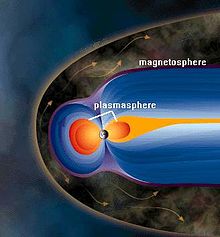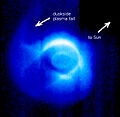Plasmasphere

The plasmasphere, or inner magnetosphere, is a region of the Earth's magnetosphere consisting of low energy (cool) plasma. It is located above the ionosphere. The outer boundary of the plasmasphere is known as the plasmapause, which is defined by an order of magnitude drop in plasma density. The plasmasphere was discovered in 1963 by Don Carpenter from the analysis of VLF whistler wave data. Traditionally, the plasmasphere has been regarded as a well behaved cold plasma with particle motion dominated entirely by the geomagnetic field and hence corotating with the Earth.
In 2014 satellite observations from the THEMIS mission have shown that density irregularities such as plumes or biteouts may form.[1] It has also been shown that the plasmasphere does not always co-rotate with the Earth. The plasma of the magnetosphere has many different levels of temperature and concentration. The coldest magnetospheric plasma is most often found in the plasmasphere, a donut-shaped region surrounding the Earth. But plasma from the plasmasphere can be detected throughout the magnetosphere because it gets blown around by electric and magnetic field. Data gathered by the twin Van Allen Probes show that the plasmasphere also limits highly energetic ultrarelativistic electrons from cosmic and solar origin from reaching low earth orbits and the surface of the planet.[2][3]
-
A view from the IMAGE satellite showing Earth's plasmasphere using its Extreme Ultraviolet (EUV) imager instrument.
-
Visualization of the radiation belts with confined charged particles (blue & yellow) and plasmapause boundary (blue-green surface).
See also
References
- ^ "NASA's THEMIS Discovers New Process that Protects Earth from Space Weather". www.nasa.gov. NASA. March 6, 2014. Retrieved April 11, 2017.
- ^ http://www.latimes.com/science/sciencenow/la-sci-sn-star-trek-invisible-shield-electron-van-allen-radiation-belts-20141126-story.html
- ^ http://newsoffice.mit.edu/2014/plasma-shield-against-harmful-radiation-1126
- Carpenter, D. L., Whistler evidence of a 'knee' in the magnetospheric ionization density profile, J. Geophys. Res., 68, 1675–1682, 1963.
- Nishida, A., Formation of plasmapause, or magnetospheric plasma knee, by combined action of magnetospheric convections and plasma escape from the tail, J. Geophys. Res., 71, 5669, 1966.
- Sandel, B. R., et al., Extreme ultraviolet imager observations of the structure and dynamics of the plasmasphere, Space Sci. Rev., 109, 25, 2003.

